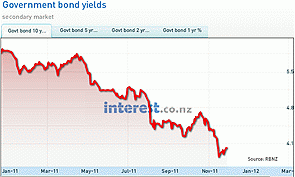
By Christian Hawkesby*
At the beginning of the year, the NZ 10 year government yield was a little under 6%.
With loose monetary policy globally, and the threat of rising inflation, most commentators began the year fearful of a sharp rise in bond yields.
Many people talked about a repeat of the famous bear market in 1994.
Anyone who doubted this view was looked on with great scepticism.
Approaching the end of the year, the NZ 10 year government bond yield has fallen to a record low below 4%.
It has been a year of earthquakes, floods, tsunamis, faltering economic recoveries, wobbling emerging markets, sovereign debt crises, and dysfunctional politics in the US and Europe.
Even those bond market bulls who were not fearful of a bond market rout never expected bond yields to fall to record lows (Chart 1).
Stepping back from the dramatic events of this year, the big questions are:
• Where is a fair value at which NZ government bonds yields may eventually settle?
• What needs to happen for the market to revert to those levels?
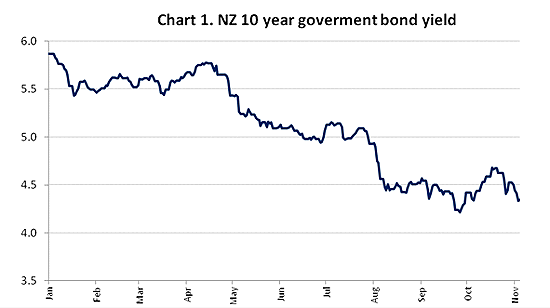
What is the ‘normal’ level for NZ bond yields?
Economic theory suggests that in the very long-run interest rates should equal the long-term nominal growth of the economy (roughly real GDP growth plus inflation) plus a risk premium to provide addition compensation to investors for a number of different factors, including:
• a default premium (once seen as relatively low for developed countries)
• a foreign exchange premium (for those countries relying on overseas investors with a different home currency)
• a term and liquidity premium (for locking up funds in securities that aren’t as liquid as cash)
Since the Reserve Bank began inflation targeting in the 1990s, the average nominal growth rate of New Zealand has been roughly 5%.
Over the same period, the 10 year government bond yield has averaged 6.5%, implying that investors have in the past demanded a risk premium of around 1.5 percentage points.
Looking forward, a quick informal survey of local macro-economists suggests they see average nominal growth over the next 10 years in a range between 4.5% and 5.5%.
Adding on the average risk premium gives you a long-run neutral 10 year bond yield between 6-7%.
The message of this simple arithmetic is clear: whereas at the beginning of the year bond yields were at roughly neutral levels, they are now decisively below their long-term resting point.
Indeed, focusing purely on this simple framework suggests NZ government bond yields are providing investors with no additional premium to compensate for the normal risks associated with holding NZ government bonds. That is, the risk premium has vanished.
A world of low bond yields in ‘core’ countries
In practice, NZ government bond yields are dictated in large part by global bond yields, and priced as a spread over equivalent US government bond yields. Historically, NZ government bond yields have been around 2 percentage points above the US, and this is broadly where they have been trading in recent months (Chart 2).
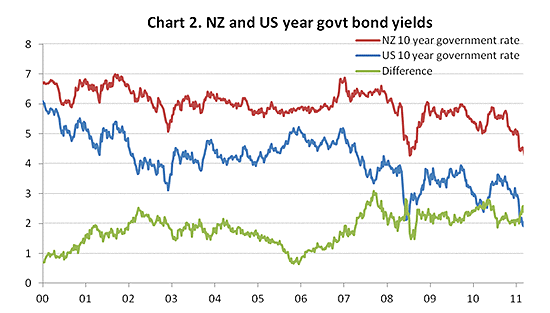
So where is fair value for US government bonds yields?
Since August this year, the US 10 year government bond yield has been trading at around 2%, driven down over the past 4 years by a series of measures by the US Federal Reserve to attempt to kick start the US economy.
These have included holding official overnight interest rates to near 0% since 2008, direct purchases of bonds to drive down yields (Quantitative Easing 1 and 2) announced in 2009 and 2010, and direct purchases of long-term bonds (Operation Twist) launched in the second half of 2011.
There is even talk that the Federal Reserve may need to embark on a third round of Quantitative Easing in 2012.
Our quick informal survey of macro-economists suggests they see average nominal growth in the US over the next 10 years in a range between 4% and 4.75%. So even taking the most pessimistic economic forecaster, and not making any allowance for a US risk premium, US bond yields are 2 percentage points below long-term fundamental levels.
In an environment of high US unemployment, low growth and the threat of deflation, US government bonds yields have remained low, regardless of the ratings downgrade from Standard & Poor’s.
And, these record low yields have been dragging down other government bonds yields in ‘core’ countries, like New Zealand.
How long to get back to Normal?
While NZ government bond yields are at record lows, and a long way below long-term fundamentals, that does not imply that they are set to rise materially from their current levels any time soon.
There are four factors that we are watching, which in part explain why yields are currently so low:
1. Global growth:
While US macroeconomic data has been improving in recent months, the US economy has a long way to go to shake off the after effects of the GFC. It needs to be generating around 200,000 jobs a month just to get in unemployment down to 8% in 12-18 months time. This points to the US Federal Reserve keeping short-term US interest rates low for a long time.
In Europe, the situation is even worse. Market conditions have deteriorated markedly since the false hope of the latest rescue package announced at the end of October. There is no clear plan or timetable for policy action. The co-ordination challenge is enormous and European growth looks set to slow further in the face of fiscal austerity.
2. NZ monetary policy:
The Reserve Bank of New Zealand (RBNZ)’s last OCR Review in October suggested that their next move in short-term interest rates would be up. Since then, following the deterioration of conditions in Europe, the market has begun to price in the chance that the RBNZ’s next move would in fact cut interest rates. While we believe it is too early to pick that course of action, we do think that the RBNZ is well positioned to keep the OCR on hold at 2.5% for well into 2012 while they assess the situation in Europe.
With the OCR on hold for a longer period of time, there is less pressure for long-term bond yields to rise (Chart 3).
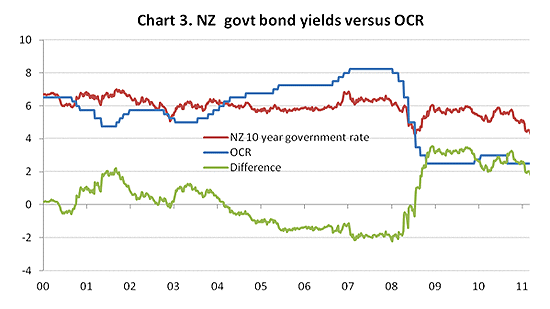
3. Credit markets:
There has been very little corporate bond issuance in New Zealand this year, and this lack of supply has helped insulate the New Zealand market from the deterioration in global credit markets.
But, in recent weeks, NZ companies that raise debt financing overseas have found those markets shut, or at least looking less reliable than was the case earlier in the year. As a result, some NZ companies have retreated to their home market to issue corporate bonds.
This increase in supply has seen local credit markets catch up with developments overseas. With liquidity deteriorating in corporate bond markets, government bonds have become an attractive safe haven.
4. NZ risk premium:
With the European sovereign crisis as the backdrop, markets have focused this year on government debt levels. In the eyes of foreign investors, the NZ government bond market has benefited from its relatively low level of net government debt to GDP.
Consequently, as the crisis has unfolded, NZ government bonds have tended to move in tandem with ‘core’ bond markets like the US and Germany, while other countries like Italy and Spain have fallen by the wayside (Chart 4).
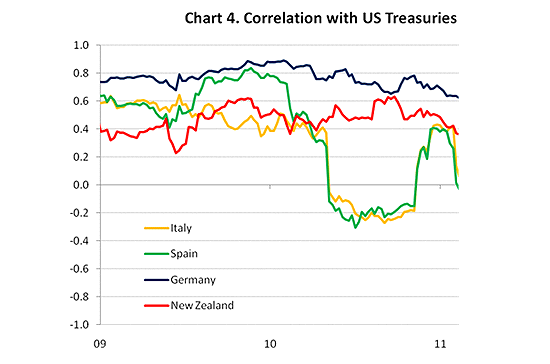
But crises tend to evolve and the focus of the market can change. NZ looks less attractive by international comparisons when measured by total debt, of both the public and private sector.
Were this metric to become a key market focus, NZ would cease to trade as a ‘core’ market and we could find our risk premium increasing, perhaps considerably.
This is New Zealand’s ‘Achilles heel’ and requires close watching.
Summary
In conclusion, the NZ 10 year government bond yield reached an all-time low of 3.82% during November, well below long-term fundamental levels.
This has been part of a wider reduction in global bond yields in ‘core’ countries, driven by low global growth, and a deteriorating European sovereign crisis increasing risk aversion.
While NZ government bond yields have risen from their lows, they remain around 4%.
Although markets hope for yet another European rescue package, the underlying factors keeping interest rate low are not likely to improve soon.
Therefore, NZ interest rates look set to stay relatively low for some time yet, especially while NZ continues to move in tandem with ‘core’ sovereign bond markets.
-------------------
Christian Hawkesby is head of Fixed Income at Harbour Asset Management
1 Comments
So there is a message there for those who care to look......if the long term bonds are 4% and the premium above growth is 1.5% then an optimistic new "normal" growth for NZ/world is <2.5%....when it needs double that.....
So the conclusion is growth is going to drop more....we will be lucky to run at +1%.....just how all these economists see way positive numbers mystifies me when you look at the fundimentals.....and Peak oil is the biggest.
regards
We welcome your comments below. If you are not already registered, please register to comment
Remember we welcome robust, respectful and insightful debate. We don't welcome abusive or defamatory comments and will de-register those repeatedly making such comments. Our current comment policy is here.